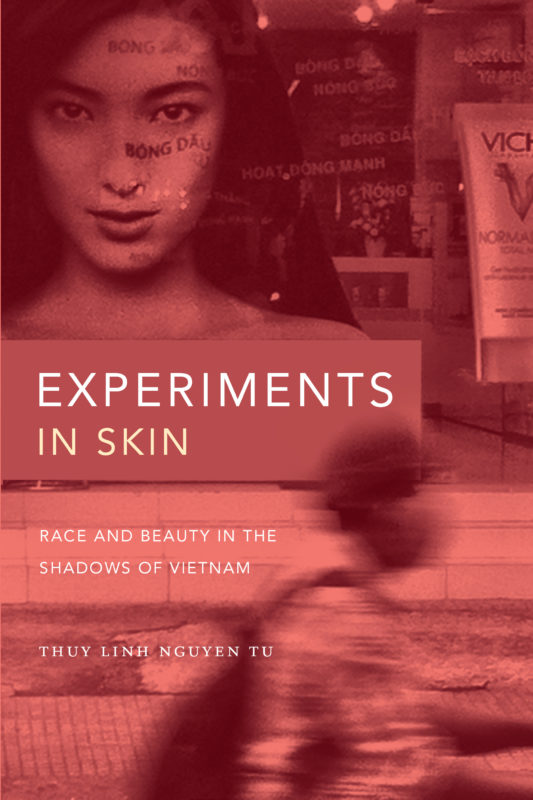
In her latest book, Experiments in Skin: Race and Beauty in the Shadows of Vietnam, New York University professor Thuy Linh Nguyen Tu sheds light on the toxic legacy of Agent Orange used during the Vietnam War by theorizing around skin. Tu sets out to ask,
“What…might an analysis of our body’s surface—of our skin as an organ (the largest and most visible), as a boundary (between self and others), as a metaphor (for the superficial and untrustworthy), and as a mark (of difference and distinction)—tell us about the entanglements of war and disease, race and beauty, [and] the U.S. and Vietnam?”
Through historical and anthropological research methods, Tu tells one story about the US military’s investment in dermatology research to treat its soldiers fighting in tropical Vietnam, and another about the modern Saigonese women who give and receive skin treatments at the Calyx spa. These two separate skin stories cross the Pacific Ocean to intersect at the making of race and beauty.
Focusing on Albert Kligman’s skin irritation experiments on Black inmates at the Holmesburg prison, and Marion Sulzberger’s visions for a white “idiophylatic soldier” with a biologically strengthened “skin of armor,” Tu shows how these two dermatologists shaped views of racial difference in the military during the Vietnam War era and beyond. Generous funding from the US military and corporations like Dow Chemicals made it possible for Kligman to research the effects of toxic agents on white and Black skin and determine that Black skin was uniquely more resilient. Denying Black pain, Kligman’s observation prompted him to subject Black skin to harsher studies. He attempted to “harden” white skin with chemicals that increased melanin, which also made the skin darker. Kligman’s prison experiments on Black skin enabled Sulzberger to imagine a white soldier that could appropriate the supposedly structurally amplified “melanocytic system” of Black skin and combat tropical acne and other anxieties of white fragility in Vietnam.
Other scholars have written extensively about the denial of Black pain in the history of medicine; even today, a 2016 study reveals that US medical students undertreat Black patients relative to white patients, based on false beliefs that Black bodies are biologically different and feel less pain than white bodies. In her work, Tu extends the idea of racial bias in pain perception to the US military’s gaze on Vietnamese bodies. She critically interprets Skin Diseases of Vietnam, 1965-1972 not simply as the Field Dermatology Research Team’s atlas of skin ailments, but, more insidiously, as an instruction manual on how to racially read skin.
Beyond epidemiological data reporting the similar, lower prevalence of certain skin infections among Vietnamese soldiers and Black American infantrymen relative to white Americans, the Field Team’s publication exclusively showed white soldiers “debilitated by a hostile landscape” of Vietnamese tropics and muck. The local Vietnamese were presented as either indifferent to pain or at play, “exist[ing]harmoniously with their environment.” Tu reads a rare image of a cheerful Black soldier in the archives in the same way: “This scene of a U.S. soldier who, like the Vietnamese farmer with his oxen or the boys with their rats, appears in harmony rather than at odds with his environment. The photographer must have been thrilled to capture this rare vision, this smiling black soldier, who bears such affective dissonance from his white comrades.” Tu concludes that the military deployed these contrasting visual narratives as a way to reroot the idea of racial hierarchies in Black and Asian bodies – to use white skin’s supposed biological fragility to legitimize race as something other than a social construction that privileged whiteness. “We might remember this instance as one of the moments when ’the Vietnamese‘ became a race—understood as having distinct characteristics that warranted differential treatment,” Tu continues. “For the Field Team’s work not only shaped a view of black and Asian bodies as analogous, but also helped to shore up their unequal treatment in the military.”
In her second story about skin, Tu locates the ways of acceptance and making do in postwar Vietnam conditions in the Calyx spa, a skincare center on the outskirts of Saigon. As the toxic legacy of Agent Orange continues to affect the population, and factory workers face exposure to dangerous chemicals in manufactured exports, Calyx becomes a communal center where aestheticians like Hoa and Nga can care for Vietnamese women’s skin traumas. These aestheticians can “read” skin, understanding their clients’ desires, history, and the reality of what they must endure to make a living. Nowhere in the book does Tu convey this more poetically than in her story about one woman who came to Calyx to have her cracking skin hands rubbed with Vitamin C and moisturizer, and finally, wrapped in silk. With careful analysis, Tu proceeds to show how this curious gesture can offer us a glimpse of “…how concealment might function as care, how hope and resignation might intertwine, and how beauty might not be the expression of a desire for individual transcendence but a longing for collective life.”
While wrapping the woman’s hands in silk was not a cure, the silk cloth offered physical relief as a silky, second skin, and emotional relief, as the woman recalled her childhood memories of making silk in her family home. The silk cloth treatment presents an example of communal care, as the idea originally came from another Calyx customer. Furthermore, by wrapping the seamstress’s hands in silk, the aesthetician Nga offered her “a cover-up, a way to live with and in a world beyond repair, beyond the false promise of the makeover…But…opacity of her skin did not make her impairments less knowable.” Tu describes how the aestheticians at Calyx sense skin depth and their epistemology of skin that separated them from experimenters like Kligman:
“While Nga continued to experiment with forms of care, skin was not her mystery to solve. And while she too wanted stronger skin, she did not imagine the body as something that could be secured. The body she saw vacillated between weak and strong, deteriorating and dazzling—was both and neither…’Things are just the way they are.’ Nga could not fix these women, any more than she could change her environment. But neither could she leave it, mourn it, valorize the remains. Vietnam may be a damaged landscape, but it was also a place where the women at Calyx continued to build lives.”
The women at Calyx wanted stronger and healthier skin, just as Kligman and Sulzberger desired for the white soldier. Tu also connects these two stories through cosmoceuticals like Retin-A that Kligman discovered in his acne research broadly supported by US military interests and now regularly used by the women at Calyx. Tu traces the violence of Kligman’s prison experiments and his racist ideas as it crossed transpacific borders to continually harm bodies of color. Still, Tu writes of the beauty she finds at Calyx. “Neither freedom nor coercion captures fully what the women at Calyx were endeavoring toward. For here was a world absolutely shaped by Albert Kligman’s work, but also outside of his reach and beyond his capacity to see.”
Experiments in Skin is a rich work that offers up so many pathways for further research. Although an academic text, Tu’s language is accessible with her extremely detailed analysis and frequent reiteration of her key points. I am excited to see how readers from various fields and backgrounds will build upon Tu’s interdisciplinary work, not only on its important subject, but on her methodology and its gestures of care and solidarity.
Experiments in Skin: Race and Beauty in the Shadows of Vietnam
by Thuy Linh Nguyen Tu
Duke University Press, $25.95
 Cathy Duong is a current Masters student at UW Seattle Genetic Counseling program. In her free time, she enjoys traveling to Little Saigons, playing V-pop on her ukulele, and analyzing diasporic Viet literature.
Cathy Duong is a current Masters student at UW Seattle Genetic Counseling program. In her free time, she enjoys traveling to Little Saigons, playing V-pop on her ukulele, and analyzing diasporic Viet literature.


